Eublepharis
The genus Eublepharis, of which one known type is the leopard geckos, were first described by the British zoologist John Edward Gray in 1827. The etymology of their name is 'eu' = good (=true) |'blephar' = eyelid, and all have fully functional eyelids. Members of this genus are found in eastern and southwestern Asia where they reside in rocky grassland habitats. These geckos are sturdily built. Their tail is shorter than their snout–vent length and their body is covered with numerous wart-like bumps. The toes do not have adhesive lamellae or membrane (Eublepharis cannot climb like their other gecko cousins). Eublepharis are crepuscular or nocturnal ground-dwellers. Included in this group is the popular pet gecko: the leopard gecko. It is especially popular in the United States, where there are nearly 3 million captive bred leopard geckos. A common misconception about leopard geckos is that they live in dry, arid deserts, but they are from rocky grasslands in southwestern Asia, including northern India, Afghanistan and Pakistan. They avoid deserts and places with low water.
| Eublepharis | |
|---|---|
 | |
| Common leopard gecko (Eublepharis macularius) | |
| Scientific classification | |
| Kingdom: | Animalia |
| Phylum: | Chordata |
| Class: | Reptilia |
| Order: | Squamata |
| Family: | Eublepharidae |
| Genus: | Eublepharis Gray, 1827 |
| Species | |
|
Eublepharis angramainyu | |
Anatomy
Leopard geckos hatch at a length of 6.5 to 8.5 cm (2.6 to 3.3 inches) and weighing approximately 3 grams. An adult of this species can reach a length of 20.5 to 27.5 cm (8.1 to 11 inches) and a weight of 54-65 grams.
Leopard geckos have tough skin around their back, neck and head, well suited to move on rocky terrain in a dry environment. Like all reptiles, they shed this skin periodically to allow for further growth.[1]
Diet
Leopard geckos eat only insects. Crickets, mealworms, waxworms, etc.[2]
Species of the genus Eublepharis
- Iraqi eyelid gecko, Eublepharis angramainyu
- West Indian leopard gecko, Eublepharis fuscus
- East Indian leopard gecko, Eublepharis hardwickii
- Common leopard gecko, Eublepharis macularius
- Afghan leopard gecko, (Eublepharis macularius afghanicus)
- Eublepharis macularius fasciolatus
- Eublepharis macularius macularius
- Eublepharis macularius montanus
- Eublepharis macularius smithi
- Satpura leopard gecko, Eublepharis satpuraensis
- Turkmenistan eyelid gecko, Eublepharis turcmenicus
The members of the Goniurosaurus kuroiwae superspecies were formerly considered members of the genus Eublepharis.
Eublepharis key identifiers
Habitats
Eublepharis can be found throughout Afghanistan, Iraq, Iran, Northwest India, and Pakistan.[3] They prefer dry, semi-dry, and more arid grassland regions.
References
- "Shedding - Leopard Gecko Wiki". leopardgeckowiki.com. Retrieved 2019-03-05.
- "Leopard Geckos Food and Diet". www.leopardgecko.co.uk. Retrieved 2019-03-05.
- "Eublepharis macularius (Common Leopard Gecko)". Animal Diversity Web. Retrieved 2018-10-24.